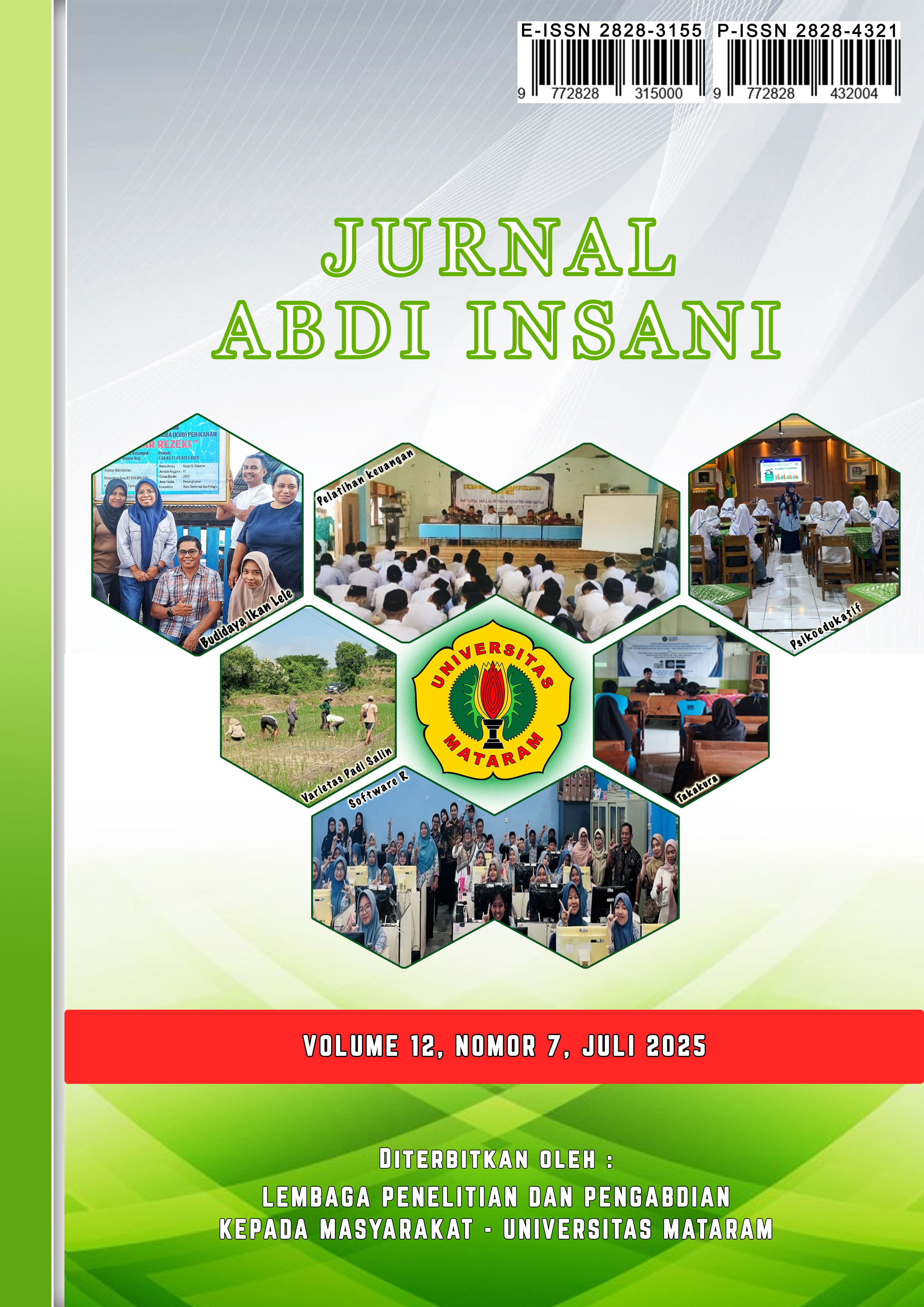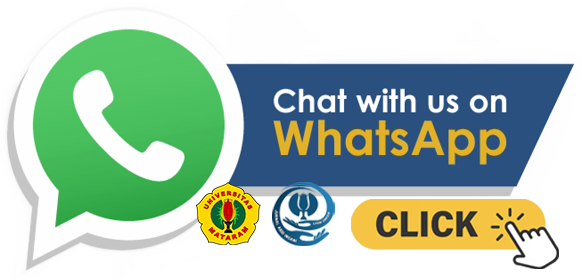APPLICATION OF PROXIMITY BEACON AS ANTI-COLLISION SENSOR USING MICROBIT FOR PROGRAMMING LEARNING OF JUNIOR HIGH SCHOOL STUDENTS AT HAMIDAH SAMPURNA SCHOOL, BANDUNG REGENCY
DOI:
https://doi.org/10.29303/abdiinsani.v12i7.2672Keywords:
Application, Sensor, Technology Literacy, Programming, MicrobitAbstract
The development of digital technology requires the young generation to have technological literacy and programming skills from an early age. To answer this challenge, the community service team from the Electrical Engineering Faculty of Telkom University carried out activities at Hamidah Sampurna Junior High School (SHS), Bandung Regency. This activity has the theme "Proximity Beacon Application Using Microbit as Anti-Collision Car Sensor." The activity was carried out on May 28, 2025 and involved various educational elements. The purpose of this activity is to introduce technology and programming to junior high school students through a practical and project-based approach. The activity method is conducted through direct training using Microbit devices designed according to the level of understanding of junior high school students. This activity also involved teachers, parents, and students with a total of 47 participants. The results of the survey showed that 63.8% of participants strongly agreed that the material was appropriate, 76.6% rated the technology presented as very useful, and 89.4% stated that the material was easy to understand. A total of 91.5% of participants hope that similar activities can be continued in the future. This activity shows the high enthusiasm of the participants and the effectiveness of the project-based approach. Collaboration between schools, parents, and universities strengthens the learning process. This activity also improves students' digital literacy and programming skills. This activity successfully builds educational synergy and is recommended to be expanded with advanced technologies such as IoT and AI.
Downloads
References
Abdurahman, A., Wiliyanti, V., & Tarrapa, S. (2024). Model pembelajaran abad 21. PT. Sonpedia Publishing Indonesia.
Cajas, F. (2002). The role of research in improving learning technological concepts and skills: The context of technological literacy. International Journal of Technology and Design Education, 12(3), 175-188.
Chang, K. E., Chiao, B. C., Chen, S. W., & Hsiao, R. S. (2000). A programming learning system for beginners-a completion strategy approach. IEEE Transactions on Education, 43(2), 211-220.
Endayani, T. B., Rina, C., & Agustina, M. (2020). Metode demonstrasi untuk meningkatkan hasil belajar siswa. azkiya, 5(2), 150-158.
Julia, J., & Isrokatun, I. (2019). Technology literacy and student practice: Lecturing critical evaluation skills. International Journal of Learning, Teaching and Educational Research, 18(9), 114-130.
Kalelioglu, F., & Sentance, S. (2020). Teaching with physical computing in school: the case of the micro: bit. Education and Information Technologies, 25(4), 2577-2603.
Leuwol, F. S., Hasyim Mahmud Wantu, S. A., Chairul Insani Ilham ATD, M. M., Nduru, M. P., Sumiyati, S., Mardikawati, B., ... & CA, M. A. (2023). Top 10 model pembelajaran abad 21. Penerbit Adab.
Liu, J., Xia, X., Bai, Y., & Liu, P. (2022, May). A study of micro: bit teaching design based on the development of computational thinking of secondary school students. In 2022 4th International Conference on Computer Science and Technologies in Education (CSTE) (pp. 198-201). IEEE.
Novamizanti, L., Tritoasmoro, I. I., Maryopi, D., Adviatmadja, S. D., Mahanani, E. L., & Tanjung, N. A. M. (2024). Penerapan Microbit untuk Menyiram Tanaman Otomatis dalam Pengajaran Robotika untuk Siswa dan Siswi SMP di Sekolah Hamidah Sampurna Kabupaten Bandung. Almufi Jurnal Pengabdian Kepada Masyarakat, 4(1), 28-33.
Novamizanti, L., Tritoasmoro, I. I., Maryopi, D., Adviatmadja, S. D., Mahanani, E. L., & Tanjung, N. A. M. (2024). Peningkatan Literasi Pemrograman melalui Hackathon 3.0 dan Implementasi Aplikasi Alarm Berbasis Microbit untuk Siswa SMP di Sekolah Hamidah Sampurna, Kabupaten Bandung. Almufi Jurnal Pengabdian Kepada Masyarakat, 4(2), 299-305.
Oliveira Aureliano, V.C., 2013, August. A methodology for teaching programming for beginners. In Proceedings of the ninth annual international ACM conference on International computing education research (pp. 169-170).
Önal, N., İlhan, A. G., Önal, N. T., & Eysink, T. H. (2025). The Effect of Micro: Bit Applications on Middle School Students' Attitudes Towards Coding. Journal of Learning and Teaching in Digital Age, 10(2), 187-198.
Quyen, K. T., Van Bien, N., & Thuan, N. A. (2023). Micro: bit in Science Education: A systematic review. Jurnal Penelitian dan Pembelajaran IPA, 9(1), 1-14.
Rafti, M., Milakis, E. D., Argyrakou, C. C., Vangeli, D. G., & Katsarou, M. C. (2025). Hands-on STEAM programming: Microteaching with Micro: Bit for enhanced learning. Journal of Hypermedia & Technology-Enhanced Learning, 3(2), 108-127.
Song, O. J., & Park, E. K. (2020). The effect of software education using micro: Bit on computational thinking of elementary school students. Journal of Knowledge Information Technology and Systems, 15(1), 37-46.
Sulaiman, S., Yendri, O., Suhirman, L., Rachmandhani, S., Baka, C., Djayadin, C., Ali, A., Judijanto, L., La'biran, R., Nurhayati, A. and Hustina, L., 2024. Metode & Model Pembelajaran Abad 21: Teori, Implementasi dan Perkembangannya. PT. Green Pustaka Indonesia.
Sun, L., & Liu, J. (2024). Micro: bit programming effects on elementary STEM teachers’ computational thinking and programming attitudes: a moderated mediation model. Journal of Research on Technology in Education, 1-23.




















